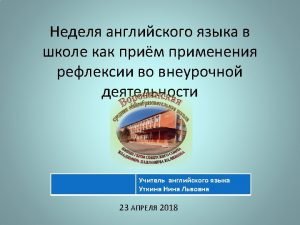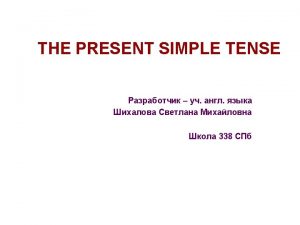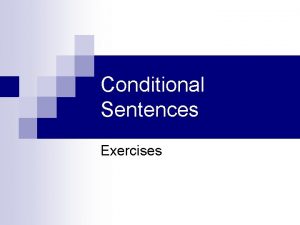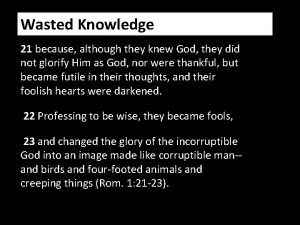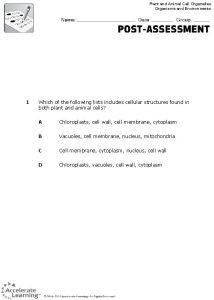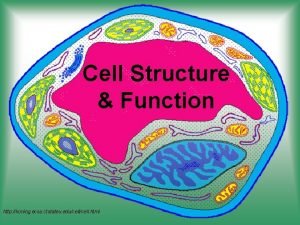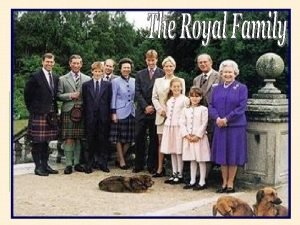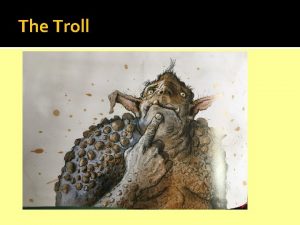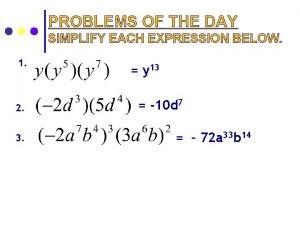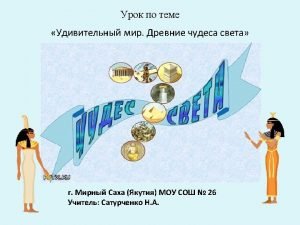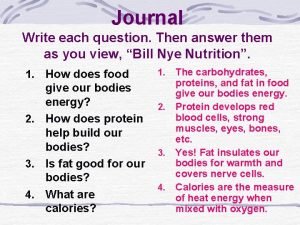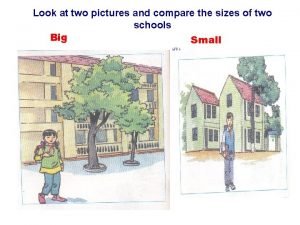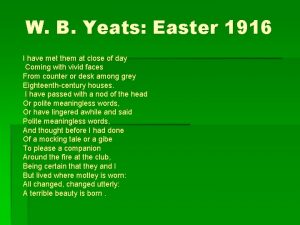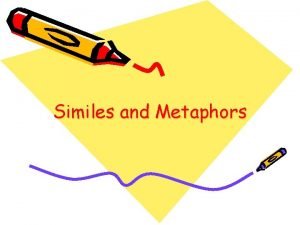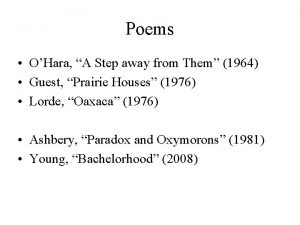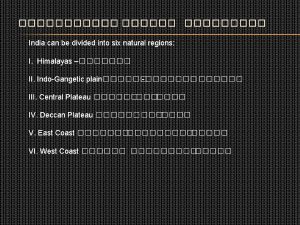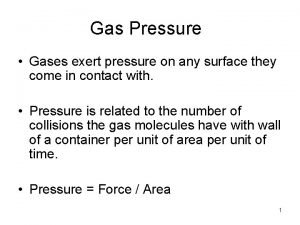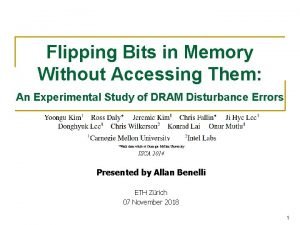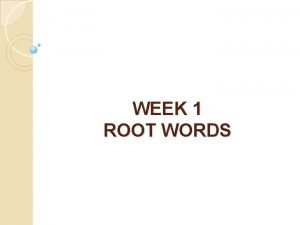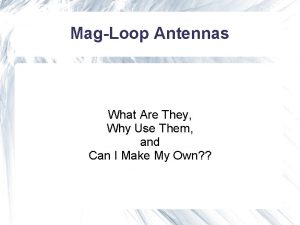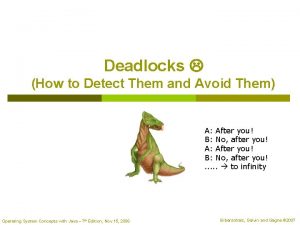What they are and how to use them



































![Modulation . . . Where the information resides V= V(t) sin[2 f(t) +p (t)] Modulation . . . Where the information resides V= V(t) sin[2 f(t) +p (t)]](https://slidetodoc.com/presentation_image_h/8d4c07f3ad3f30093c64405c9fb20a6d/image-36.jpg)

![Modulation: Analog Frequency Modulation c V= V(t) sin[2 f t +p m(t)] b b Modulation: Analog Frequency Modulation c V= V(t) sin[2 f t +p m(t)] b b](https://slidetodoc.com/presentation_image_h/8d4c07f3ad3f30093c64405c9fb20a6d/image-38.jpg)
![Modulation: Analog Phase Modulation c V= V(t) sin[2 f t +p m(t)] b b Modulation: Analog Phase Modulation c V= V(t) sin[2 f t +p m(t)] b b](https://slidetodoc.com/presentation_image_h/8d4c07f3ad3f30093c64405c9fb20a6d/image-39.jpg)










![Digital Modulation PSK Implementation: IQ Method V= Vo sin[2 ft +p (t)] f = Digital Modulation PSK Implementation: IQ Method V= Vo sin[2 ft +p (t)] f =](https://slidetodoc.com/presentation_image_h/8d4c07f3ad3f30093c64405c9fb20a6d/image-50.jpg)
![Digital Modulation PSK Implementation: IQ Method I: Vo cos[f(t)] = { Vo 2 2 Digital Modulation PSK Implementation: IQ Method I: Vo cos[f(t)] = { Vo 2 2](https://slidetodoc.com/presentation_image_h/8d4c07f3ad3f30093c64405c9fb20a6d/image-51.jpg)

















- Slides: 68

What they are and how to use them Source Basics 1

Agenda l l Types of sources CW Swept Signal Generator l Block Diagrams l Applications l Specifications 2

Sources Generate Sine Waves Frequency Voltage Time Oscilloscope Spectrum Analyzer This is the ideal output: most specs deal with deviations from the ideal and adding modulation to a sine wave Millimeter Microwave RF 3 -6 GHz 20 -30 GHz 300 GHz 3

Types of Sources l CW – generates l Swept a single frequency, fixed sine wave – sweeps over a range of frequencies – may be phase continuous l Signal Generator – adds modulation – produces "real world" signal 4

Agenda l l Types of sources CW Swept Signal Generator l Block Diagrams l Applications l Specifications 5

CW Source Specifications. . . Frequency . l l l Range: Range of frequencies covered by the source Resolution: Smallest frequency increment. Accuracy: How accurately can the source frequency be set. EXAMPLE Accuracy = Voltage Uncertainty Frequency +_ f CW * t aging * t cal f CW = = t aging = t cal CW frequency = 1 GHz aging rate = 0. 152 ppm/year time since last calibrated = 1 year Ù Accuracy = 152 +_Hz 6

CW Source Specifications. . . Amplitude l l l Range (-136 d. Bm to +13 d. Bm) Accuracy (+/- 0. 5 d. B) Resolution (0. 02 d. B) Switching Speed (25 ms) Reverse Power Protection Source protected from accidental transmission from DUT What is P Voltage DUT out? max How accurate is this number? What is P out? min Frequency 7

CW Source Specifications. . . Spectral Purity Phase Noise l Residual FM l Spurious l CW output residual FM is the integrated phase noise over 300 Hz - 3 k. Hz BW sub-harmonics 0. 5 f 0 phase noise harmonic spur ~30 d. Bc non-harmonic spur ~65 d. Bc 2 f 0 8

CW Source Specifications. . . Spectral Purity: Phase Noise Power Spectral Density CW output measured as d. Bc/Hz frequency TRACE A: -75 d. B* Ch 1 PM PSD A Marker Y* = radrms^2/Hz -104. 177 d. B* 10 000 Hz Log. Mag 5 d. B /div -125 d. B* 1 k Start: 500 Hz 10 k 100 k Stop: 100 k. Hz 9

CW Block Diagram Synthesizer Section – – range resolution switching speed spectral purity Output Section – – range level accuracy amplitude switching speed reverse power protection Reference Section – – frequency stability accuracy 10

RF CW Block Diagram Synthesizer Section Frac-N Output Section ALC Modulator Phase Detector Output Attenuator f VCO divide by X Reference Oscillator Reference Section ALC Driver ALC Detector ALC = automatic level control 11

RF CW Block Diagram Reference Section to synthesizer section Phase Detector f divide by X Optional External Reference Input Aging Rate Temperatur e Line Voltage Reference Oscillator (TCXO or OCXO) TCXO OCXO +/- 2 ppm/year +/- 0. 1 ppm /year +/- 1 ppm/year +/- 0. 01 ppm/year +/- 0. 5 ppm/year +/- 0. 001 ppm/year 12

RF CW Block Diagram Synthesizer Section . . . produces accurate, clean signals N = 93. 1 control Frac-N 5 MHz Phase Detector f X VCO 2 multiplier to output section 931 MHz 5 MHz from reference section 465. 6 MHz 13

RF CW Block Diagram Synthesizer Section PLL / Fractional - N. . . suppresses phase noise of source noise phase-locked-loop (PLL) bandwidth selected for optimum noise performance reference oscillator phase detector noise 20 log. N broadband noise floor VCO noise frequency 14

RF CW Block Diagram Output Section l ALC –maintains output power by adding/subtracting power as needed l Output Attenuator or electronic –provides attentuation to achieve wide output range (e. g. -136 d. Bm to +13 d. Bm) from synthesizer section ALC Modulator Output Attenuator source output –mechanical ALC Driver ALC Detector ALC = automatic level control 15

m. Wave CW Block Diagram Reference Section Frac N Phase Det ALC Modulator f Output Attenuator VCO Sampler by X Ref Osc YIG Oscillator Phase Detector f Tuning Coils ALC Driver Frac-N Phase Detector Synthesizer Section f VCO ALC Detector Output Section 16

m. Wave CW Block Diagram Reference Section Frac-N Phase Detector 300 - 350 MHz f to synthesizer section VCO 10 MHz multiply by X f Ext Ref 30 MHz x 3 Reference Oscillator 17

m. Wave CW Block Diagram Synthesizer Section Sampler from reference section IF n = 29 then f = 8. 99 GHz and f = 20 LO MHz divide by x IF Phase Detector Frac N Phase Detector 9. 01 GHz f Tuning Coils divide by y YIG Oscillator f from reference section VCO 18

m. Wave CW Block Diagram Synthesizer Section Comb Generator Sampler mixes one of the harmonics with the output of the YIG oscillator 310 MHz 8. 99 GHz n=1 2 3 4 27 28 29 30 31 5 frequency 19

Applications & Critical Specifications l Local Oscillator – phase noise – frequency accuracy l Amplifier Distortion – spurious – TOI l (for system) Receiver Testing – Spurious spurious è level accuracy è 20

Applications & Critical Specifications As a Local Oscillator DUT IF signal transmitter output poor phase noise spreads energy into adjacent channels poor frequency accuracy will cause transmitter to be at the wrong frequency 21

Applications & Critical Specifications Amplifier Testing f 1 Intermodulation Distortion DUT output RF f 2 isolator f 1 f 2 test system third order products will also fall here amplitude spurious signals from source can corrupt measurement f L = 2 f 1 - f 2 f U = 2 f 2 - f 1 frequency 22

Applications & Critical Specifications Receiver Testing Spurious Immunity in-channel signal (modulated signal) IF signal out-of-channel signal (CW or modulated signal) DUT source output IF Rejection Curve Level (d. Bm) spur from source and/or high levels of phase noise can cause a good receiver to fail Frequency 23

Agenda l l Types of sources CW Swept Signal Generator l Block Diagrams l Applications l Specifications 24

Sweeper Specifications. . . Frequency ramp sweep – – – accuracy sweep time resolution f 2 frequency l f 1 time step sweep – – – accuracy number of points switching time frequency l t 2 f 4 f 3 f 2 f 1 t 2 t 3 t 4 25

Sweeper Specifications. . . Amplitude Frequency Sweep l Level Accuracy l Flatness Source Match (SWR) power level accuracy spec flatness spec f 1 P 2 power Power Sweep l Power Sweep Range Power Slope Range l Source Match (SWR) P 1 frequency f 2 } power sweep range 26

Sweeper Block Diagram Frequency Sweep: Open Loop Phase continuous l PLL open l Synthesize start frequencies l Tuning characteristics must be precisely known l from reference section m. Wave Source: Synthesizer Section Sampler 9. 01 GHz divide by x Phase Detector f divide by y YIG Oscillator S/H Tuning Coils DAC 27

Sweeper Block Diagram Frequency Sweep: Closed Loop Fully synthesized sweep l Phase continuous within l PLL never loses lock l Limited frequency range l Frac-N RF Source: Synthesizer Section Phase Detector f VCO 28

Sweeper Block Diagram Power Sweep l l l Drive ALC Modulator Level accuracy maintained Broad sweeps may require switching output attentuator from synthesizer section ALC Modulator Output Attenuator source output Output Section ALC Driver ALC Detector 29

Applications & Critical Specifications l Frequency Response – – – l Frequency Accuracy Output Power (Level) Accuracy Flatness Speed residual FM Amplifier Compression – Power Range 30

Applications & Critical Specifications Frequency Response Testing Sweeper Input Frequency Accuracy l Output Power (Level) Accuracy l Flatness l Speed l residual FM l LO 31

Applications & Critical Specifications Frequency Response Testing Who Cares About Accuracy? 1: Transmission Log Mag 5. 0 d. B/ Ref -15. 00 d. B BW: 429. 600 MHz CF: 2405. 782 MHz Q: 5. 60 Loss: -0. 84 d. B 5 1 0 3 -5 5 6 -10 Ch 1 -20 -25 -30 1 -35 Abs Center 2 450. 212 MHz Span 1 099. 577 MHz 32

Applications & Critical Specifications Amplifier Compression Power Range 1 d. B compression point Power Out l Power In The 1 d. B compression point is a common amplifier specification used to identify the linear operating range of an amplifier. Power sweep is available on some HP sources. 33

Agenda l l Types of sources CW Swept Signal Generator l Block Diagrams l Applications l Specifications 34

Signal Generators Calibrated, variable frequency over a broad range l Calibrated, variable ouput level over a wide dynamic range l Calibrated modulation l – – – Analog (AM, FM, Pulse) Digital (IQ) Format Specific 35
![Modulation Where the information resides V Vt sin2 ft p t Modulation . . . Where the information resides V= V(t) sin[2 f(t) +p (t)]](https://slidetodoc.com/presentation_image_h/8d4c07f3ad3f30093c64405c9fb20a6d/image-36.jpg)
Modulation . . . Where the information resides V= V(t) sin[2 f(t) +p (t)] f AM, Pulse FM PM V= V(t) sin[ (t)] q 36

Modulation: Analog Amplitude Modulation Carrier Important Signal Generator Specs for Amplitude Modulation Voltage Time l l Modulation frequency Linear AM Log AM Depth of modulation (Mod Index) 37
![Modulation Analog Frequency Modulation c V Vt sin2 f t p mt b b Modulation: Analog Frequency Modulation c V= V(t) sin[2 f t +p m(t)] b b](https://slidetodoc.com/presentation_image_h/8d4c07f3ad3f30093c64405c9fb20a6d/image-38.jpg)
Modulation: Analog Frequency Modulation c V= V(t) sin[2 f t +p m(t)] b b = D Fdev /Fmod Important Signal Generator Specs for Frequency Modulation l l Voltage l Time l l Frequency Deviation Modulation Frequency dc. FM Accuracy Resolution 38
![Modulation Analog Phase Modulation c V Vt sin2 f t p mt b b Modulation: Analog Phase Modulation c V= V(t) sin[2 f t +p m(t)] b b](https://slidetodoc.com/presentation_image_h/8d4c07f3ad3f30093c64405c9fb20a6d/image-39.jpg)
Modulation: Analog Phase Modulation c V= V(t) sin[2 f t +p m(t)] b b = Df peak Important Signal Generator Specs for Phase Modulation l Voltage l Time l l Phase deviation Rates Accuracy Resolution 39

Modulation: Analog PM is Really the Same as FM. . . FM Modulator c V= V(t) sin[2 f t +p m(t)] b PM Modulator b = Df peak b = D Fdev /Fmod 40

Modulation: Analog Voltages of FM/PM Frequency Components Bessel Functions of the First Kind 1 J 0 0. 8 J 1 0. 6 J 2 0. 4 J 3 J 4 0. 2 J 5 0 J 6 -0. 2 J 7 -0. 4 J 8 -0. 6 J 9 0. 0 2. 0 4. 0 6. 0 b 8. 0 9. 9 J 10 5. 52 41

Modulation: Analog Pulse Modulation T Rise time Power Rate=1/T Pulse Important Signal Generator Specs for Pulse Modulation On/Off ratio t l l l Time l Width Pulse width Pulse period On/Off ratio Rise time 1/T Power 1/t 42

Signal Generator Block Diagram FM and PM control Frac-N Phase Detector to output section f X VCO divide by X 2 multiplier d/dt function generator from reference section external FM/PM input 43

Signal Generator Block Diagram AM and Pulse ALC Modulator Burst Modulator Output Attenuator from synthesizer section function generator Ext AM source output ALC Driver Burst Mod Driver ALC Detector ALC Hold Ext Pulse 44

Digital Modulation . . . signal characteristics to modify Amplitude Frequency Phase Both Amplitude and Phase 45

Digital Modulation . . . Amplitude Shift Keying (ASK) V= V(t) sin[2 ft + p] V(t) f = RF waveform V = 46

Digital Modulation . . . Phase Shift Keying (BPSK) V= Vo sin[2 ft +p (t)] f f (t) = f 1 f 2 47

Digital Modulation . . . Phase Shift Keying (QPSK) V= Vo sin[2 ft +p (t)] f f (t) = f 1 = 3 f 2 = /4 p p/4 f 3 = f 4 = - 3 p/4 /4 p 48

Digital Modulation PSK Implementation: PLL Method Frac-N Phase Detector f VCO f(t) d/dt Reference Oscillator external modulation input 49
![Digital Modulation PSK Implementation IQ Method V Vo sin2 ft p t f Digital Modulation PSK Implementation: IQ Method V= Vo sin[2 ft +p (t)] f =](https://slidetodoc.com/presentation_image_h/8d4c07f3ad3f30093c64405c9fb20a6d/image-50.jpg)
Digital Modulation PSK Implementation: IQ Method V= Vo sin[2 ft +p (t)] f = Vo cos[ (t)]fsin[2 ft] + p Vo sin[ (t)] f sin[2 ft + p/2] f (t) = p f 1 = 3 f 2 = /4 p p/4 f 3 = - p/4 f 4 = - 3 /4 p 50
![Digital Modulation PSK Implementation IQ Method I Vo cosft Vo 2 2 Digital Modulation PSK Implementation: IQ Method I: Vo cos[f(t)] = { Vo 2 2](https://slidetodoc.com/presentation_image_h/8d4c07f3ad3f30093c64405c9fb20a6d/image-51.jpg)
Digital Modulation PSK Implementation: IQ Method I: Vo cos[f(t)] = { Vo 2 2 p/2 Q: Vo sin[f(t)] = { Vo sin[2 pft] 2 2 Vo 2 2 l l l Good Interface with Digital Signals and Circuits Can be Implemented with Simple Circuits Can be Modified for Bandwidth Efficiency 51

Digital Modulation QPSK IQ Diagram Q 01 Vo 00 2 2 I Vo 2 2 11 10 52

Digital Modulation Polar Display: Magnitude & Phase Represented Together ag M Phase 0 deg Magnitude is an absolute value l Phase is relative to a reference signal l 53

Digital Modulation Signal Changes or Modifications ag M Phase 0 deg Magnitude Change Phase 0 deg Phase Change 0 deg Both Change Frequency Change 54

Digital Modulation Accuracy Q Magnitude Error (IQ error mag) { Test Signal f Error Vector Ideal (Reference) Signal Phase Error (IQ error phase) I 55

Digital Signal Generator Block Diagram IQ Modulator – reference section (supplies timing) modulation quality to output section Baseband Generator – modulation quality – adjacent channel performance – supported modulation formats 56

Digital Signal Generator Block Diagram IQ Modulator I from Baseband Generator Ext I DAC from synthesizer section p/2 to output section DAC Ext Q Q from Baseband Generator 57

Digital Signal Generator Block Diagram Baseband Generator From CPU Analog Reconstruction Filters Pattern RAM Constellation Map and Baseband Filters Data Clock DAC I DAC Q Timing Symbol Clock 58

Digital Signal Generator Digital Signals US-TDMA Parameter Specification Access Method TDMA/FDD Modulation p/4 DQPSK Channel Bandwidth 30 k. Hz Reverse Channel Frequency Band 824 - 849 MHz Forward Channel Frequency Band 869 - 894 MHz Filtering 0. 35 RRC 59

Digital Signal Generator Access and Framing one frame = 1944 bits (972 symbols) = 40 ms; 25 frames/sec slot 1 slot 2 slot 3 slot 4 slot 5 slot 6 324 bit (162 symbols) = 6. 667 ms G 6 R 6 Data Sync Data 16 28 122 Mobile to Base Station SACCH CDVCC Data 12 12 122 60

Applications and Critical Specifications Analog and Digital l Receiver Sensitivity – – – l Receiver Selectivity – – – l frequency accuracy level accuracy error vector magnitude phase noise spurious spectral accuracy Spectral Regrowth – ACP performance 61

Applications and Critical Specifications Receiver Sensitivity l Frequency Accuracy frequency inaccuracy amplitude inaccuracy Want to measure sensitivity in a channel Measurement impaired by frequency inaccuracy input for signal generator DUT 62

Applications and Critical Specifications Receiver Sensitivity l Level Accuracy Customer is testing a -110 d. B sensitivity pager: -110 d. B specification X X X O Actual output power= -114 d. Bm Set source to -115 d. Bm Frequency Case 1: Source has +/-5 d. B of output power accuracy at -100 to -120 d. Bm output power. Power Out X= Failed unit O=Passed unit -110 d. B specification X X Set source to -111 d. Bm O O O Actual output power= -112 d. Bm O Frequency Case 2: Source has +/-1 d. B of output power accuracy at -100 to -120 d. Bm output power. 63

Applications and Critical Specifications Receiver Sensitivity l Error Vector Magnitude (EVM) e. g. TETRA Signal p/4 DQPSK EVM < 1. 0% Error Vector 64

Applications and Critical Specifications Receiver Selectivity l l Phase Noise Spurious in-channel signal (modulated signal) IF signal out-of-channel signal (CW or modulated signal) DUT Level (d. Bm) IF Rejection Curve spur from source and/or high levels of phase noise can cause a good receiver to fail Frequency fnd. B = amar + aadj + as - 10 log(Be/1 Hz) 65

Applications and Critical Specifications Receiver Selectivity Spectral Accuracy: l EVM l ACP GSM Signal 0. 3 GMSK 66

Applications and Critical Specifications Spectral Regrowth l ACP Performance DUT Output from amplifier Input from signal generator 67

Summary l l Types of sources CW Swept Signal Generator l Block Diagrams l Applications l Specifications 68
 Mikael ferm
Mikael ferm If you cant beat them join them
If you cant beat them join them What you dont know wont hurt
What you dont know wont hurt I you we they do
I you we they do Which organelle transports them where they need to go?
Which organelle transports them where they need to go? I my mine
I my mine Rankings: what are they and do they matter?
Rankings: what are they and do they matter? Overhead cost per unit
Overhead cost per unit Lucrativae
Lucrativae They use all day swimming
They use all day swimming If we'd seen you we (stop)
If we'd seen you we (stop) They seek him here they seek him there
They seek him here they seek him there Because you have rejected me i have rejected you
Because you have rejected me i have rejected you They are they which testify of me
They are they which testify of me Grammar rules frustrate me they're not logical they are so
Grammar rules frustrate me they're not logical they are so For they not know what they do
For they not know what they do Knowledge not shared is wasted
Knowledge not shared is wasted How you use ict today and how you will use it tomorrow
How you use ict today and how you will use it tomorrow Animal cells
Animal cells And draw them all along and flow
And draw them all along and flow Revision passive voice
Revision passive voice It is a market form of meat sold as hard as stone.
It is a market form of meat sold as hard as stone. Can you make them behave king george fact and opinion
Can you make them behave king george fact and opinion Look at the pictures and talk about them
Look at the pictures and talk about them In your notebook write questions and answer
In your notebook write questions and answer Is evaluating alternatives and making choices among them.
Is evaluating alternatives and making choices among them. Evaluating alternatives and making choices among them
Evaluating alternatives and making choices among them Riddle about biomolecules
Riddle about biomolecules Locate
Locate Cracks in rocks widen as water in them freezes and thaws
Cracks in rocks widen as water in them freezes and thaws Chapter 8 thinking language and intelligence
Chapter 8 thinking language and intelligence Hooke saw tiny openings in cork and named them
Hooke saw tiny openings in cork and named them Us and them analysis
Us and them analysis Let them notice
Let them notice The power process notice your pictures
The power process notice your pictures Look at the photos and match them with the words in the box
Look at the photos and match them with the words in the box Fantastic beasts and where to find them book
Fantastic beasts and where to find them book Simplify each expression and then arrange them in
Simplify each expression and then arrange them in Look at the pictures and match
Look at the pictures and match Match them 292
Match them 292 Learn and share in english 2
Learn and share in english 2 God gave them over to their enemies
God gave them over to their enemies Reprobate mind definition
Reprobate mind definition In your notebook write questions and answer
In your notebook write questions and answer Field mice bopping them on the head
Field mice bopping them on the head Write the questions and then answer them
Write the questions and then answer them Look at these two pictures and contrast
Look at these two pictures and contrast And god blessed them
And god blessed them Peatscrapes
Peatscrapes Onomatopoeia literary definition
Onomatopoeia literary definition Linking words song
Linking words song Easter 1916 yeats
Easter 1916 yeats Tag questions everyone
Tag questions everyone Activity 1 name game
Activity 1 name game Poems with simile metaphor and personification
Poems with simile metaphor and personification What punishment does the prince give romeo for fighting?
What punishment does the prince give romeo for fighting? Soldiers before and after war
Soldiers before and after war Jim crow acrostic poem
Jim crow acrostic poem Honor them that have rule over you
Honor them that have rule over you Let's let them object to another one
Let's let them object to another one India can be divided into dash natural regions
India can be divided into dash natural regions Do gases exert pressure on whatever surrounds them
Do gases exert pressure on whatever surrounds them Flipping bits in memory without accessing them
Flipping bits in memory without accessing them Do gases exert pressure on whatever surrounds them
Do gases exert pressure on whatever surrounds them Total health foods
Total health foods Difference between them
Difference between them Ambi root word
Ambi root word Oo u oul words
Oo u oul words Teach them diligently nashville
Teach them diligently nashville

